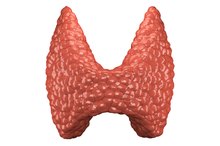Melatonin & Thyroid Disorders
The most common disorders of the thyroid gland are hyperthyroidism and hypothyroidism 12. Hyperthyroidism is a condition in which the thyroid gland secretes too much thyroid hormone, and hypothyroidism results in insufficient amounts of thyroid hormone 12. Both hyperthyroidism and hypothyroidism have been linked to cell damage 12. The sleep-regulating hormone melatonin can protect against cell damage. However, it may also down-regulate the activity of the thyroid gland. So melatonin could worsen hypothyroidism 12.
Oxidative Stress
You need oxygen to turn the components of food into energy that your body can use. Though this metabolic process is essential to staying alive, it also produces toxic and unstable byproducts called free radicals. Free radicals are produced when electrons are removed from an atom or molecule. Free radicals take in electrons from other cell molecules. This can lead to cell damage and abnormalities in cell growth, a condition called oxidative stress. Antioxidants, such as selenium, beta-carotene and vitamins C and E, can help prevent cell damage by giving an electron to free radicals.
- You need oxygen to turn the components of food into energy that your body can use.
- Antioxidants, such as selenium, beta-carotene and vitamins C and E, can help prevent cell damage by giving an electron to free radicals.
Hyperthyroidism
L-Carnitine & Hypothyroidism
Learn More
Hyperthyroidism, or overactive thyroid, is most commonly a result of an autoimmune disease, a condition in which your immune system attacks the thyroid gland 1. Occasionally, hyperthyroidism can result from a non-cancerous tumor in the thyroid gland or an infection of the thyroid gland 1. Hyperthyroidism results in an increased secretion of the thyroid hormones T3 and T4 1. Excess thyroid hormones in the bloodstream lead to an increased metabolic rate. As a higher metabolism requires higher amounts of oxygen to produce the needed energy, hyperthyroidism can result in oxidative stress 1.
Hypothyroidism
Hypothyroidism, or underactive thyroid, is most often an autoimmune condition or the result of treating hyperthyroidism by removing the thyroid gland or treating it with radioactive idodine 12. When the thyroid gland is underactive, smaller amounts of the thyroid hormones T3 and T4 are secreted into the bloodstream, decreasing your metabolism. Whether hypothyroidism leads to oxidative stress is unclear 2. A study published in the November 2010 issue of "Clinical Chemistry and Laboratory Medicine” found that hypothyroidism is correlated with increased levels of low-density lipoprotein, or bad cholesterol, which can lead to oxidative stress 24. Thus hypothyroidism may be an indirect source of oxidative stress 2.
Melatonin
How to Use Melatonin to Treat Acid Reflux
Learn More
Melatonin is derived from the mood-enhancing neurotransmitter serotonin in the pineal gland. It regulates your 24-hour sleep rhythm and is commonly used to prevent jet lag, to cure sleep disorders and to adjust the sleep rhythm in people who work nightshifts. Melatonin is also a potent antioxidant and can be used to prevent oxidative stress. According to a review published in the April 2002 issue of “Neuro Endocrinology Letters,” however, melatonin may down-regulate the activity of the thyroid gland 3. So melatonin may be beneficial as a supplement for individuals with hyperthyroidism, but taking a melatonin supplement with hypothyroidism could worsen the condition 12.
- Melatonin is derived from the mood-enhancing neurotransmitter serotonin in the pineal gland.
- It regulates your 24-hour sleep rhythm and is commonly used to prevent jet lag, to cure sleep disorders and to adjust the sleep rhythm in people who work nightshifts.
Related Articles
References
- MayoClinic.com: Hyperthyroidism
- MayoClinic.com: Hypothyroidism
- "Neuro Endocrinology Letters"; Melatonin and the Thyroid Gland; A. Lewinski, et al.; April 2002
- "Clinical Chemistry and Laboratory Medicine"; Association Between Thyroid Hormones...; A. Santi, et al.; November 2010
- Madame Curie Bioscience Database; Melatonin and the Thyroid Gland; Andrzej Lewinski; December 2005
- Andrew Weil, M.D.; Stumped by Oxidative Stress?; March 17, 2009
- InformedHealth.org. Underactive thyroid: Overview. Updated August 10, 2017.
- Segni M. Disorders of the Thyroid Gland in Infancy, Childhood and Adolescence. In: Feingold KR, Anawalt B, Boyce A, et al., editors. Endotext. Updated March 18, 2017.
- Almandoz JP, Gharib H. Hypothyroidism: etiology, diagnosis, and management. Med Clin North Am. 2012;96(2):203-21. doi:10.1016/j.mcna.2012.01.005
- Biondi B, Wartofsky L. Combination treatment with T4 and T3: toward personalized replacement therapy in hypothyroidism?. J Clin Endocrinol Metab. 2012;97(7):2256-71. doi:10.1210/jc.2011-3399
- Hennessey JV, Espaillat R. Current evidence for the treatment of hypothyroidism with levothyroxine/levotriiodothyronine combination therapy versus levothyroxine monotherapy. Int J Clin Pract. 2018;72(2):e13062. doi:10.1111/ijcp.13062
- Jonklaas J, Bianco AC, Bauer AJ, et al. Guidelines for the treatment of hypothyroidism: prepared by the american thyroid association task force on thyroid hormone replacement. Thyroid. 2014;24(12):1670–1751. doi:10.1089/thy.2014.0028
- Garber J et. al. Clinical Practice Guidelines for Hypothyroidism in Adults: Cosponsored by the American Association of Clinical Endocrinologists and the American Thyroid Association. Endocr Pract. 2012 Nov-Dec;18(6):988-1028.
- American Thyroid Association. (n.d.). Hypothyroidism (Underactive).
- Braverman, L, Cooper D. Werner & Ingbar's The Thyroid, 10th Edition. WLL/Wolters Kluwer; 2012.
- Surks MI. (2017). Clinical manifestations of hypothyroidism. Ross DS, ed. UpToDate. Waltham, MA: UpToDate Inc.
- Sworczak K, Wisniewski P. The role of vitamins in the prevention and treatment of thyroid disorders. Endokrynol Pol. 2011;62(4):340-44.
Writer Bio
Dr. Berit Brogaard has written since 1999 for publications such as "Journal of Biological Chemistry," "Journal of Medicine and Philosophy" and "Biology and Philosophy." In her academic research, she specializes in brain disorders, brain intervention and emotional regulation. She has a Master of Science in neuroscience from University of Copenhagen and a Ph.D. in philosophy from State University of New York at Buffalo.









